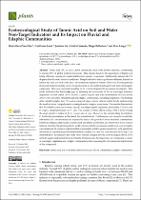Por favor, use este identificador para citar o enlazar este ítem:
https://repositorio.usj.es/handle/123456789/1100
| Título : | Ecotoxicological Study of Tannic Acid on Soil and Water Non-Target Indicators and Its Impact on Fluvial and Edaphic Communities |
| Autor: | Pino Otín, Rosa


Lorca, Guillermo Val Pulido, Jonatan Ferrando, Natalia 

Ballestero Fernández, Diego Langa Morales, Elisa 
|
| Palabras clave : | Edaphic communities; Fluvial communities; Soil ecotoxicity; Tannic acid; Water ecotoxicity |
| Fecha de publicación: | 30-nov-2023 |
| Editorial : | MDPI |
| Citación : | Pino-Otín, M.R.; Lorca, G.; Val, J.; Ferrando, N.; Ballestero, D.; Langa, E. Ecotoxicological Study of Tannic Acid on Soil andWater Non-Target Indicators and Its Impact on Fluvial and Edaphic Communities. Plants 2023, 12, 4041. https:// doi.org/10.3390/plants12234041 |
| Resumen : | Tannic acid (TA) is a key tannin extensively used in the leather industry, contributing to around 90% of global leather production. This practice leads to the generation of highly polluting effluents, causing environmental harm to aquatic ecosystems. Additionally, tannins like TA degrade slowly under natural conditions. Despite efforts to reduce pollutant effluents, limited attention has been devoted to the direct environmental impact of tannins. Moreover, TA has garnered increased attention mainly due to its applications as an antibacterial agent and anti-carcinogenic compound. However, our understanding of its ecotoxicological effects remains incomplete. This study addresses this knowledge gap by assessing the ecotoxicity of TA on non-target indicator organisms in both water (Vibrio fischeri, Daphnia magna) and soil environments (Eisenia foetida, Allium cepa), as well as natural fluvial and edaphic communities, including periphyton. Our findings offer valuable insights into TA's ecotoxicological impact across various trophic levels, underscoring the need for more comprehensive investigations in complex ecosystems. Our results demonstrate that TA exhibits ecotoxicity towards specific non-target aquatic organisms, particularly V. fischeri and D. magna, and phytotoxicity on A. cepa. The severity of these effects varies, with V. fischeri being the most sensitive, followed by D. magna and A. cepa. However, the soil-dwelling invertebrate E. foetida shows resistance to the tested TA concentrations. Furthermore, our research reveals that substantial TA concentrations are required to reduce the growth of river microbial communities. Metabolic changes, particularly in amino acid and amine metabolism, are observed at lower concentrations. Notably, the photosynthetic yield of river periphyton remains unaffected, even at higher concentrations. In contrast, soil microbial communities exhibit greater sensitivity, with significant alterations in population growth and metabolic profiles at a very low concentration of 0.2 mg/L for all metabolites. In summary, this study offers valuable insights into the ecotoxicological effects of TA on both aquatic and terrestrial environments. It underscores the importance of considering a variety of non-target organisms and complex communities when assessing the environmental implications of this compound. |
| URI : | https://repositorio.usj.es/handle/123456789/1100 |
| ISSN : | 2223-7747 |
| Aparece en las colecciones: | Artículos de revistas |
Ficheros en este ítem:
| Fichero | Descripción | Tamaño | Formato | |
|---|---|---|---|---|
| Ecotoxicological Study of Tannic.pdf | 4,78 MB | Adobe PDF |  Visualizar/Abrir |
Este ítem está sujeto a una licencia Creative Commons Licencia Creative Commons

